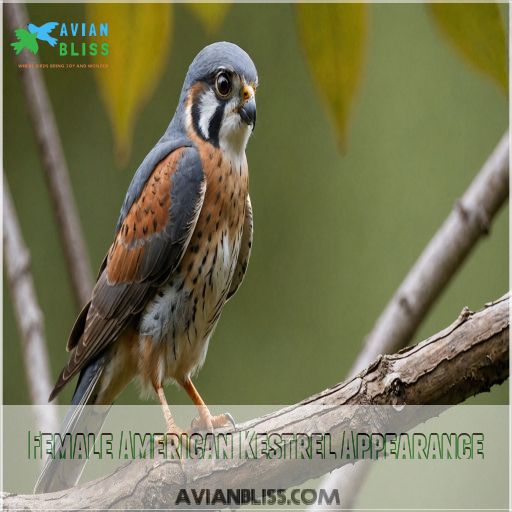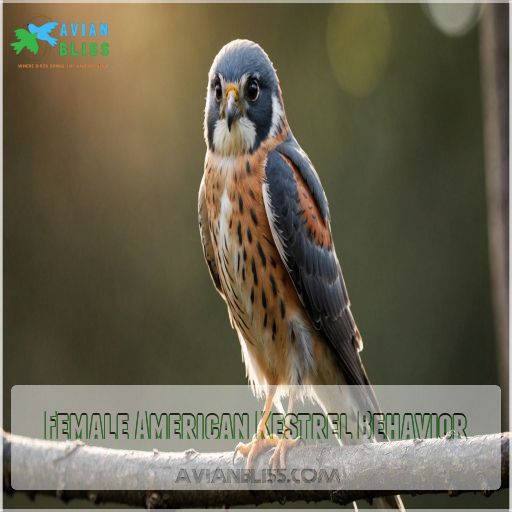This site is supported by our readers. We may earn a commission, at no cost to you, if you purchase through links.

These fierce, rusty-brown beauties leave quite an impression with their black barred plumage and distinctive cheek stripes. Unlike their dapper male counterparts boasting blue-gray tails, these ladies rock a rufous tail with black barring.
Slightly larger than males, they’re adept hunters, often tackling bigger prey.
As parents, they’re front and center in nesting duties, choosing cozy woodpecker holes and handling incubation like pros.
Their vocal skills aren’t to be overlooked either, with both charming calls and shrill alarms.
There’s more to uncover about these skyward predators, with females taking the lead in many aspects. Females are also known to have distinctive cheek stripes.
Table Of Contents
- Key Takeaways
- Female American Kestrel Appearance
- Key Differences Between Male and Female
- Female American Kestrel Behavior
- Role in Raising Young
- Communication and Vocalizations
- American Kestrel General Information
- Conservation Status and Threats
- Unique Characteristics and Adaptations
- Conservation Efforts and Partnership
- Frequently Asked Questions (FAQs)
- How can you tell a female kestrel?
- What’s the difference between a male and female kestrel?
- What is special about the American Kestrel?
- What is the difference between the common kestrel and the American Kestrel?
- What is the typical diet of female kestrels?
- How does migration timing differ between females and males?
- In what habitats do female kestrels overwinter?
- Do female kestrels use nesting boxes?
- How do weather conditions affect female kestrel hunting?
- Conclusion
Key Takeaways
- You’ll spot these feisty females by their rusty-brown plumage with black barring – they’re like nature’s camouflage artists, blending in while still looking fabulous. Unlike their blue-tailed male counterparts, ladies rock a rufous tail with dark bars, proving that in the bird world, fashion isn’t just for the boys.
- Don’t let their small size fool you – female kestrels are the heavyweight champions of their weight class. They’re slightly larger than males and often tackle bigger prey, showing that in the kestrel world, the ladies aren’t afraid to punch above their weight.
- These aerial acrobats are masters of the "killy-killy" call and aren’t shy about using it. Whether they’re sounding the alarm or sweet-talking their mate, female kestrels have a whole repertoire of vocalizations that would put any opera singer to shame.
- You can play a part in helping these pint-sized predators thrive. By supporting conservation efforts, installing nest boxes, or even just spreading the word about their awesomeness, you’re joining Team Kestrel in the fight against cardinal habitat loss and other threats
. Who knew being a bird nerd could be so awesome?
Female American Kestrel Appearance
When you spot a female American Kestrel, her mostly brown plumage with black barring stands out, creating a subtle yet striking appearance.
You’ll notice her distinctive slate-blue head and black-striped cheeks are as charming as her agility in the sky.
Color Pattern and Plumage
When identifying a female American Kestrel, you’ll notice her distinctive plumage: a rich tapestry of chestnut brown and rufous hues with black barring.
This color pattern isn’t just for show—it’s her secret weapon for camouflage.
She lacks the slate blue of her male counterpart, offering unique seasonal beauty and blending perfectly into her natural habitat.
Distinctive Head Features
Female American Kestrels, or Falco sparverius, sport a head that’s a masterpiece of nature.
You’ll notice:
- Black cheek stripes that echo a masked superhero.
- A slate blue crown reminiscent of a dusty, enchanted sky.
- Unique facial markings with "ocelli," giving an illusion of eyes on the back.
Unlike the more flamboyant male, these features create a balanced elegance.
Wing and Tail Characteristics
Now, let’s talk wings and tails.
The female American Kestrel flaunts rusty wings and a tail with striking black bar patterns, unlike the male’s blue-gray adornments.
Her wing shape aids her flight adaptations, allowing nimble maneuvers like a sparrow hawk.
Meanwhile, that "killy hawk" call announces her presence with flair—an avian diva!
Key Differences Between Male and Female
If you’re trying to tell a male American Kestrel from a female, color and size are your best clues.
Think of the males as the flashier dressers with vibrant oranges and blues, while the females sport a more earthy, brown-toned look, packing a slightly larger punch in size.
Color Variation
The female American kestrel’s plumage is quite distinct from her male counterpart.
Her rusty-brown upperparts are barred with black, while her underparts are pale with brown streaks.
This color variation serves as camouflage, helping her blend into her surroundings during nesting and hunting.
The intensity and extent of these markings can also vary regionally across North and Central America.
Size and Weight Comparison
Size variation between male and female American Kestrels is like a subtle dance. She’s a bit heftier by about 10-15%, though he’s no slouch in the skies!
Here’s how they stack up:
| Trait | Male | Female |
|---|---|---|
| Weight (g) | 80-143 | 86-165 |
| Prey Size | Smaller | Larger |
| Nest Box Fit | Snug | Cozy |
These differences impact prey and nesting strategies.
Distinctive Tail Features
As you appreciate the female American Kestrel’s unique tail features, imagine her perched on utility lines like a queen surveying her territory.
Her rufous tail with black barring and a narrow subterminal band contrasts with the male’s.
Key tail features include:
- Tail-bar patterns
- Tail-tip markings
- Tail-color contrasts
These traits enhance balance and agility during flight.
Female American Kestrel Behavior
You’re about to uncover the fascinating behavior of female American Kestrels—from their adept hunting skills, usually involving larger prey than their male counterparts.
to their migration habits, where they take their time and arrive fashionably late. Imagine these small but fierce birds, like the superheroes of backyard raptors, defying expectations as they manage both nesting duties and the challenges of motherhood.
Hunting and Prey Capture
Imagine this: the female American Kestrel hovers like a mini helicopter, scanning the earth for unsuspecting prey.
She’s got sharp eyes and an arsenal of hunting techniques up her sleeve.
From insects to small mammals, her prey preferences are broad.
Success rates? Not too shabby. Talk about power and precision in one agile, feathery package! (Source)
Breeding and Nesting Habits
Every spring, female American Kestrels begin a nesting quest, often choosing old woodpecker holes—think fixer-uppers for birds.
Once settled, they skip flashy nesting materials, opting for bare digs.
Eggs arrive soon after, and both parents, like an avian tag team, handle incubation duties over roughly 26-32 days, ensuring their fluffy chicks hatch ready to face the world.
Migration Patterns
The female American Kestrel, after tending to her nesting duties, follows fascinating migration patterns. Her journey involves incredible solo treks after leaving breeding grounds, showcasing adaptability and strength. You’ll find these birds traveling diverse routes to wintering sites, adjusting for food and weather.
- Latitudinal trekking from northern breeding areas.
- Factors affecting timing and distance.
- Varies by individual needs.
- Partial migratory behavior.
- Exploration of new habitats.
Role in Raising Young
As the primary caretakers, female American kestrels play a key role in raising their young.
From excavating the nest and incubating the eggs to feeding and caring for the chicks, these fierce yet devoted mothers rely on their male partners to assist in providing for the family.
Nesting and Incubation
Selecting the perfect nesting site can be as challenging as finding your keys in a messy drawer.
American Kestrels rely on cavities, old woodpecker holes, or nest boxes for egg laying.
The incubation period lasts 26 to 32 days, with attentive care ensuring hatching success.
Chicks develop quickly, catching freedom’s scent as they grow.
Feeding and Parental Care
You’ve got nature’s dynamic duo! Female kestrels hang around the nest, especially early on, keeping their little ones warm.
Meanwhile, Mr. Kestrel fetches the "fast food" prey.
But wait a bit, and Mrs. Kestrel joins the hunt, ensuring chick development thrives.
This teamwork dances around food sources and nestling survival, balancing roles with finesse.
Partnership With Males
Although female American Kestrels handle most incubation, the male-female cooperation is really important. Males often bring food, sharing prey like headless mice, during this time.
This dynamic duo’s teamwork makes sure nest defense and resource provision.
There’s a division of labor: females stay with nestlings initially while males hunt. Engaging rituals, including food exchanges, enhance their bond.
The male-female cooperation and teamwork ultimately ensure the success of the kestrels, with division of labor being a key aspect.
Communication and Vocalizations
When you’re a female American Kestrel, communication isn’t just about squawking—it’s an art of blending whines and klee calls to keep everyone in the loop.
These vocalizations, ranging from soft whines to loud alarm sounds, are the kestrel’s way of chatting with partners and chicks.
Ensuring everyone’s on the same feathered page is crucial, and this is achieved through the kestrel’s unique vocalizations, which can be described as the kestrel’s way of chatting with partners and chicks.
Core Calls and Whining Sounds
Ever wondered how American Kestrels chat?
During the breeding season, females use their unique vocalizations to communicate specific messages.
The "whining calls" serve as their secret code for:
- Courtship and bonding
- Signaling readiness for breeding
- Strengthening mate connections
- Establishing territory boundaries
These calls aren’t just noise; they’re an artful symphony of purpose and connection.
Loud Calls and Alarm Sounds
You’re in for a treat with kestrel vocalizations!
Their loud alarm calls—like those "klee-klee-klee" sounds—serve as distress signals when predators are near, playing a key role in communication.
Ever seen a kestrel’s vocal prowess in action? It’s like watching nature’s own security system in flight, with a soundtrack that commands attention.
Variations in Calls and Chirps
The American kestrel’s vocal repertoire showcases remarkable diversity.
From the iconic klee-klee-klee calls to whining chirps, their vocalizations convey a range of messages.
Chicks use begging quivers to summon food, while adults issue alarm calls to warn of predators.
Call variations can even reflect individual differences or seasonal changes.
American Kestrel General Information
You’re about to explore the fascinating world of the female American Kestrel, often dubbed "sparrow hawk" or "killy hawk," with its striking facial markings.
This little falcon, about the size of a Blue Jay, possesses unique "false eyes" on the back of its head to confuse potential predators—nature’s built-in decoy!
Nicknames and Common Names
Listening to the American Kestrel’s distinctive "killy-killy" call, you might wonder about its nicknames. Known regionally as "sparrow hawk" and "grasshopper hawk," these names reflect both historical origins and cultural significance.
Imagine the kestrel’s etymology unfolding in your mind with every shrill note they make.
Here’s a quick nibble:
- Sparrow Hawk: Historical misidentification
- Grasshopper Hawk: Preferred prey
- Killy Hawk: Unique vocalization
- Regional Variations: Cultural flair
Size and Appearance Comparison
Glance skyward, and you’ll spot the American Kestrel—a pint-sized powerhouse with striking size and appearance differences.
While females flaunt brown plumage patterns with bold bars, males flash blue-gray wings and plumage.
Their wingspan is modest, yet these differences in plumage and weight (with females slightly larger) add spice to the aerial drama of these agile hunters.
False Eyes and Facial Markings
Not just a pretty face, the American Kestrel sports false eyes, or ocelli, on the back of its head, acting like rearview mirrors for predator defense.
These visual cues, along with its distinct black facial markings, create a clever camouflage.
It’s like wearing sunglasses on the back of your head—stylish and strategic!
Conservation Status and Threats
You might think that the biggest threat to female American Kestrels is their smaller size, but it’s actually habitat loss and those pesky pesticides messing with their food supply.
As these adaptable raptors face nesting cavity shortages, they’re in a real pickle trying to find a safe home to raise their young.
Population Declines and Habitat Loss
The American Kestrel faces trouble due to habitat loss and urban adaptation
. With fewer places to nest, these feisty falcons need your help.
Here’s how you can assist:
- Support Conservation: Engage in local kestrel monitoring.
- Create Nesting Sites: Install nesting boxes.
- Advocate for Policy Changes: Promote avian-friendly land use.
- Educate Yourself and Others: Spread the word about kestrel challenges.
Pesticide Impact and Prey Depletion
Sadly, the widespread use of pesticides and the alarming decline in insect populations may be taking a toll on the American Kestrel’s food supply.
As these small falcons rely heavily on insects and other arthropods, any disruption to their prey base could seriously impact their survival and breeding success.
Conservationists are working to address these threats through sustainable pest control strategies reducing pesticide exposure and habitat restoration efforts
.
Nesting Cavity Limitation
Imagine a crowd fighting for limited apartment spaces—that’s nesting cavity scarcity for female American kestrels.
These vibrant falcons compete fiercely for cavities in trees or boxes, essential for raising chicks.
With cavity availability dwindling due to habitat loss, consider supporting cavity conservation or installing alternative nesting sites to help these kestrels find their dream homes.
Unique Characteristics and Adaptations
When you observe a female American Kestrel, you’ll notice her exceptional speed and agility in flight.
She’s a versatile hunter, adapting to various habitats with specialized hunting techniques that highlight her keen intelligence and resourcefulness.
Speed and Agility in Flight
Picture the American kestrel as a nimble aerial acrobat, dazzling with flight adaptations and swift hunting maneuvers.
With wing morphology crafted for agility, it performs impressive hovering techniques—like a mini helicopter—before diving for its next meal.
This buoyant falcon masters the sky with both speed and grace, putting on a show that’s part nature documentary, part thrill ride.
Adaptation to Various Habitats
Embracing diverse environments, the female American Kestrel deftly chooses nesting sites to optimize food availability and avoid predators.
Whether hovering over open fields or nesting in cozy tree cavities, they adapt gracefully to climate changes and human interactions.
Nest boxes, a clever human collaboration, further bolster their survival, offering stability in a world increasingly shaped by change.
Specialized Hunting Techniques
Female American Kestrels are skilled hunters, mastering various techniques for catching prey.
They excel in:
- Hovering: Like a mini helicopter, kestrels hang in the air spotting mice below.
- Perch hunting: With sharp eyesight, they scan fields from high perches.
- Aerial dives: Swift and precise, they snatch insects mid-flight.
It’s akin to a raptor ballet, blending power and elegance.
Conservation Efforts and Partnership
You can help the American Kestrel by getting involved in conservation efforts through the American Kestrel Partnership.
From monitoring local populations to spreading awareness in your community, there’s a role for everyone, and your participation could be the missing piece in saving these magnificent birds.
Your involvement can make a difference, as the American Kestrel Partnership offers various opportunities for individuals to contribute to the conservation of the American Kestrel.
American Kestrel Partnership Initiatives
You’re in luck – the American Kestrel Partnership has been hard at work to safeguard these magnificent falcons.
From collaborating with universities on cutting-edge research to engaging citizen scientists in nest box monitoring, their multifaceted approach is making a real difference for kestrels across North America.
Get involved and be part of the solution!
Monitoring and Research Opportunities
Exploring opportunities in citizen science, the American Kestrel Partnership offers a nest box study, shedding light on population trends and habitat mapping.
You can actively participate in kestrel health research while experiencing nature’s wonders firsthand.
Who knew you could discover such power by helping these falcons find homes? It’s not just birdwatching; it’s being part of a larger conservation conversation .
The American Kestrel Partnership is a valuable resource for those interested in the species.
Community Involvement and Education
Involve yourself in kestrel conservation by joining citizen science efforts like eastern bluebird habitats restoration or nest box building
.
It’s not just about the birds; it’s a community-driven adventure! Educational outreach programs invite you to explore the life of this colorful falcon.
You might find yourself discovering new skills and allies along the way, helping save these incredible avian acrobats (Source).
Frequently Asked Questions (FAQs)
How can you tell a female kestrel?
Look for rufous coloring on the head, wings, and back, with black barring.
Female kestrels lack the blue-gray wings of males and have a rufous tail with bars and a shorter black band.
What’s the difference between a male and female kestrel?
Imagine a falcon fashion show: males strut in blue-gray wings with rufous accents, while females rock all-brown ensembles.
You’ll spot the difference in their plumage, with ladies sporting barred tails and gents flaunting solid ones.
Size-wise, she’s slightly bigger.
What is special about the American Kestrel?
You’ll be amazed by the American Kestrel’s colorful plumage and fierce intensity packed into a tiny body.
They’re expert hoverers, using their tails like helicopters to stay in place while hunting.
Plus, they’ve got UV vision to spot prey urine trails.
What is the difference between the common kestrel and the American Kestrel?
American Kestrels are smaller and more colorful than Common Kestrels.
You’ll notice their slate-blue wings (males) or rust-and-black barred wings (females), while Common Kestrels have brown plumage.
American Kestrels also primarily hunt insects, whereas Common Kestrels target small birds and mammals.
What is the typical diet of female kestrels?
Female kestrels have a diverse diet that’ll keep you on your toes.
They’re nature’s little hunters, feasting on large insects like grasshoppers, small mammals, birds, reptiles, and even the occasional bat.
Talk about a power lunch!
How does migration timing differ between females and males?
Hold onto your feathers!
Females typically migrate earlier than males, thanks to their speedy molt.
This groovy timing difference stems from their parental roles – ladies finish nesting duties sooner, freeing them up for an early departure, due to their differing parental roles, specifically their parental roles (Source).
In what habitats do female kestrels overwinter?
You’ll find these feathered females favoring open habitats with short vegetation in winter.
They’re drawn to grasslands, shrubby areas, and agricultural fields where they can easily spot prey.
It’s notable that they often claim these territories before their male counterparts arrive.
Do female kestrels use nesting boxes?
Did you know over 20 hectares of open space can attract these feisty fliers?
You bet they use nesting boxes!
They’re not picky, happily settling into man-made homes or natural cavities, as long as there’s room to swoop.
How do weather conditions affect female kestrel hunting?
Weather greatly impacts hunting success.
Wind affects hovering ability, while rain can obscure prey.
Sunny days boost visibility, making insects easier to spot.
You’ll find these adaptable raptors adjusting their techniques to match the conditions, and they are very adaptable raptors.
Conclusion
Like a feathered firework in the sky, the female American Kestrel continues to dazzle and inspire.
You’ve learned about her unique appearance, behaviors, and key role in the ecosystem. From her rusty plumage to her fierce hunting skills, she’s a reflection of nature’s diversity.
As you venture outdoors, keep an eye out for these remarkable birds. By understanding and appreciating the female American Kestrel, you’re not just observing wildlife—you’re becoming a steward of these magnificent creatures and their habitats.












